
Revolutionizing Agriculture: AI for Crop Growth Monitoring
As agriculture faces increasing pressures from climate change and growing global populations, innovative solutions are essential for sustaining food production. Enter the groundbreaking artificial intelligence (AI) model crafted by researchers at the Beijing Academy of Agriculture and Forestry Sciences, which enhances crop growth monitoring using minimal field data. This advance not only promises efficient farming practices but also supports the broader goals of food security and sustainability.
A New Approach to Leaf Area Index Monitoring
The Leaf Area Index (LAI) is crucial for assessing crop growth and productivity. Traditional retrieval methods often struggle due to environmental variability and the complexities of plant structures. These challenges can impede accurate measurements, especially when there’s little data on how crops behave across different years and growth stages.
However, the new study, published in the journal Plant Phenomics, demonstrates a novel method that combines synthetic datasets and transfer learning. This dual approach successfully compensates for the scarcity of data typically gathered through time-consuming and expensive field trials. By leveraging multispectral drone data, researchers have opened new avenues for cost-effective and scalable crop monitoring over multiple seasons.
The Power of Synthetic Datasets
One of the most impressive facets of this research is the generation of synthetic spectral datasets using a 3D radiative transfer model (RTM). These datasets, validated against real multi-year UAV observations, allow for a comprehensive analysis of diverse maize canopy architectures and biochemical traits. In doing so, they mitigate limitations posed by traditional methods.
This integration of artificial data incorporates a spectrum of physiological and environmental variabilities, providing a richer context for the analysis. In essence, the researchers created a simulation of real conditions that can yield better insights than relying solely on what has been collected on the ground.
Transfer Learning: Bridging the Gap
The knowledge-guided convolutional neural network (KGCNN) utilized in the study incorporates transfer learning, a technique that enhances the model's predictive capabilities even with limited field data. By pre-training on synthetic data and fine-tuning with actual field samples, the model showcased remarkable generalization, achieving R² values up to 0.53 and RMSE as low as 0.49 across different growth stages.
This transformative approach allows for more consistent and accurate retrieval of LAI, greatly outperforming traditional models and other machine learning techniques such as RNN, LSTM, and random forests. In fact, while many alternatives suffer from under- or overestimation, the KGCNN combined with transfer learning maintains reliability even under challenging conditions.
The Implications for Future Farming
The implications of this research extend far beyond individual farms. By utilizing advanced AI technologies, farmers may soon benefit from precise tools that enhance productivity, enabling better decision-making regarding crop management and resource allocation. This model not only emphasizes the potential of AI in agriculture but also highlights how technology can be harnessed to tackle global issues like food insecurity.
Creating Sustainable Solutions
As we confront dire predictions about climate change's impact on agriculture, innovations like the KGCNN represent critical steps toward sustainable farming practices. They not only enhance efficiency but also align with the modern demands of standard biological practices and biotech solutions in agriculture.
To achieve a prosperous future, embracing such advancements in technology will be essential—ultimately leading to healthier ecosystems and communities. Knowing how to leverage these developments is key for farmers and stakeholders committed to elevating agricultural standards.
 Add Row
Add Row  Add
Add 




Write A Comment